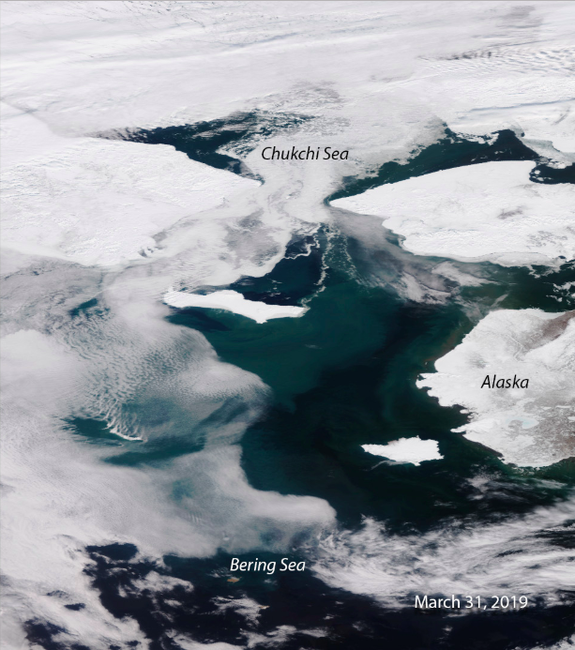Satellite photos show how pitiful ice cover is in the Arctic right now

Happy early spring. This is the time of year that Arctic sea ice often reaches its greatest size, freezing over the vast northern ocean. But in 2019, this ice cover — called the maximum ice extent — is meager, particularly in the usually ice-clad Bering Sea.
The National Oceanic and Atmospheric Administration (NOAA) released a comparison of Bering and Chukchi sea ice in 2014 (a normal year) versus the maximum sea ice extent this year. As you can see, where there is supposed to be ice, there is a great open ocean — months ahead of schedule.
It's the lowest sea ice extent on record for the Bering Sea.

Image: noaa

Image: noaa
In the greater Arctic, 2019 tied for the seventh lowest maximum ice extent in four decades of satellite records. This is part of a now-unquestionable, wide-scale planetary trend.
The Arctic is the fastest warming region on Earth.
March 2019's total #Arctic sea ice extent was tied for the 7th lowest in the passive microwave satellite record. Note that there is large year-to-year variability in addition to a long-term trend. pic.twitter.com/Utxd2ZDgNb
— Zack Labe (@ZLabe) April 1, 2019
A month ago, the Bering Sea forewarned of a profoundly low maximum sea ice extent. The waters in the Bering Strait were already nearly ice-free, though scientists expected some ice to grow as more favorable weather patterns set in. But a month later, the ice is gone.
What's more, the ice should be here for months longer. "There should be ice here until May," Lars Kaleschke, a climate scientist at the Alfred Wegener Institute for Polar and Marine Research, told Mashable in March.
SEE ALSO: An appreciation of the persistently grim tweets from the Norway Ice Service
Though NOAA is studying the exact causes for the record-low sea ice, Arctic sea ice today is getting hit on multiple fronts. The warming ocean plays an outsized role. Specifically, as more ice melts, there's less bright ice cover to reflect the sun. Instead, the dark ocean absorbs more heat, warming the region even more. Then, of course, there's warming of the atmosphere. In March 2019, extremely high temperatures — stoked by a combination of weather events and longer-term climate change — blanketed Alaska, breaking all-time and daily records around the state.
It was the warmest March on record for nearly all of Alaska. Deadhorse, Alaska, hit a whopping 40 degrees Fahrenheit above normal.
Here are the daily departures from normal for Deadhorse, AK the last 7 days:
+31.9°F above normal
+33.0°F above normal
+38.0°F above normal
+36.5°F above normal
+36.0°F above normal
+40.0°F above normal
+38.4°F above normal@AlaskaWx— Brian Brettschneider (@Climatologist49) April 1, 2019
Exacerbating matters are storms in the Bering Sea, which roll through and batter whatever sea ice is left. There will be little to no sea ice here before the onset of summer, allowing the sea to stock itself with even more heat before the warm season, noted Rick Thoman, a climate specialist for the Alaska Center for Climate Assessment and Policy at the University of Alaska Fairbanks.
Meanwhile, after a long, sun-drenched summer, the melted Arctic reaches its lowest sea ice extent, or minimum, in late September. This year promises to fit the trend: The 12 lowest ice extents on record have all occurred in the last 12 years.
"The changes in the Arctic are happening faster than they’re happening anywhere else on the rest of the planet," Jeremey Mathis, a NOAA oceanographer, told Mashable.
WATCH: Jordan Peele explains the childhood experience that made him love horror


